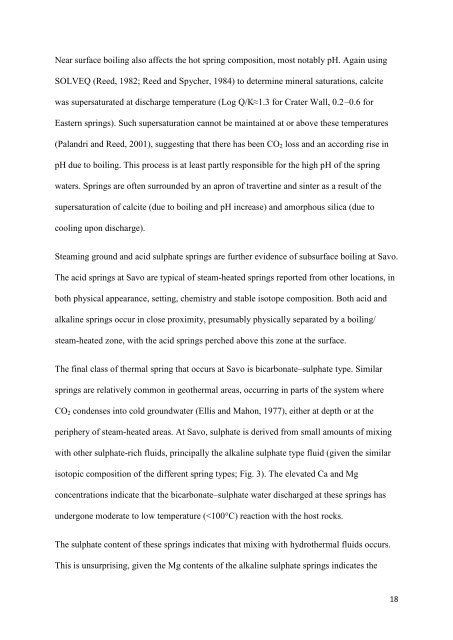Alkaline sulphate fluids produced in a magmatic hydrothermal system
Alkaline sulphate fluids produced in a magmatic hydrothermal system
Alkaline sulphate fluids produced in a magmatic hydrothermal system
You also want an ePaper? Increase the reach of your titles
YUMPU automatically turns print PDFs into web optimized ePapers that Google loves.
Near surface boil<strong>in</strong>g also affects the hot spr<strong>in</strong>g composition, most notably pH. Aga<strong>in</strong> us<strong>in</strong>g<br />
SOLVEQ (Reed, 1982; Reed and Spycher, 1984) to determ<strong>in</strong>e m<strong>in</strong>eral saturations, calcite<br />
was supersaturated at discharge temperature (Log Q/K≈1.3 for Crater Wall, 0.2–0.6 for<br />
Eastern spr<strong>in</strong>gs). Such supersaturation cannot be ma<strong>in</strong>ta<strong>in</strong>ed at or above these temperatures<br />
(Palandri and Reed, 2001), suggest<strong>in</strong>g that there has been CO 2 loss and an accord<strong>in</strong>g rise <strong>in</strong><br />
pH due to boil<strong>in</strong>g. This process is at least partly responsible for the high pH of the spr<strong>in</strong>g<br />
waters. Spr<strong>in</strong>gs are often surrounded by an apron of travert<strong>in</strong>e and s<strong>in</strong>ter as a result of the<br />
supersaturation of calcite (due to boil<strong>in</strong>g and pH <strong>in</strong>crease) and amorphous silica (due to<br />
cool<strong>in</strong>g upon discharge).<br />
Steam<strong>in</strong>g ground and acid <strong>sulphate</strong> spr<strong>in</strong>gs are further evidence of subsurface boil<strong>in</strong>g at Savo.<br />
The acid spr<strong>in</strong>gs at Savo are typical of steam-heated spr<strong>in</strong>gs reported from other locations, <strong>in</strong><br />
both physical appearance, sett<strong>in</strong>g, chemistry and stable isotope composition. Both acid and<br />
alkal<strong>in</strong>e spr<strong>in</strong>gs occur <strong>in</strong> close proximity, presumably physically separated by a boil<strong>in</strong>g/<br />
steam-heated zone, with the acid spr<strong>in</strong>gs perched above this zone at the surface.<br />
The f<strong>in</strong>al class of thermal spr<strong>in</strong>g that occurs at Savo is bicarbonate–<strong>sulphate</strong> type. Similar<br />
spr<strong>in</strong>gs are relatively common <strong>in</strong> geothermal areas, occurr<strong>in</strong>g <strong>in</strong> parts of the <strong>system</strong> where<br />
CO 2 condenses <strong>in</strong>to cold groundwater (Ellis and Mahon, 1977), either at depth or at the<br />
periphery of steam-heated areas. At Savo, <strong>sulphate</strong> is derived from small amounts of mix<strong>in</strong>g<br />
with other <strong>sulphate</strong>-rich <strong>fluids</strong>, pr<strong>in</strong>cipally the alkal<strong>in</strong>e <strong>sulphate</strong> type fluid (given the similar<br />
isotopic composition of the different spr<strong>in</strong>g types; Fig. 3). The elevated Ca and Mg<br />
concentrations <strong>in</strong>dicate that the bicarbonate–<strong>sulphate</strong> water discharged at these spr<strong>in</strong>gs has<br />
undergone moderate to low temperature (
















